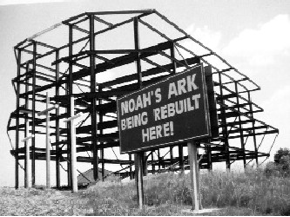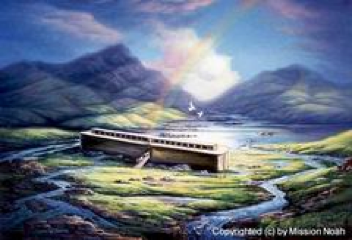The Bible tells us (Gen 6:5-13) that there was a time when the earth was filled with violence and all men were corrupt. God saw the wickedness of man and decided to destroy his creation with a great flood. But there was one righteous man by the name of Noah who found favor in the eyes of God. Noah was instructed by God to build an Ark large enough to contain two of every living thing with additional space to store a year’s supply of food. When the Ark was completed, it began to rain and the flood waters rose and destroyed all creatures except for Noah, his family, and the animals in the Ark.
I last heard this Bible story in Sunday school as a child of 7 and for the past 70 years have merely regarded any flood deep enough to cover the whole earth simply a figment of the Bible writer’s imagination. I also believed that it was impossible for one man using only primitive tools to build a boat the size of today’s ocean liners. However, recently I have begun to rethink the whole story of Noah, the building of an ark, and the flood. My readings on the subject have led me to believe that the Flood did in fact occur and that in all likelihood the Ark could have been built with the knowledge possessed by those early Babylonians. To understand how Noah was able to gather together two of every creature and keep them alive for over a year requires a leap of faith.
Three hours south of Poland, Ohio, is the small town of Frostburg, Maryland, located on Interstate Route 68 about 14 miles west of Cumberland, Maryland. Each time I drove pass Frostburg I would look for the four story metal structure with a sign next to the highway stating,“NOAH’S ARK BEING REBUILT HERE.”I have always considered this sign as some kind of practical joke until this summer when I read Timothy Beal’s 2005 book called “Roadside Religion.”

Mr. Beal, a religion professor at Case Western Reserve University, examined the Frostburg site and reported that in fact an ark is being built to the vast biblical dimensions of 450 feet long, 75 feet high, and 45 feet wide. It seems that in 1974 Pastor Richard Greene of the Church of the Brethren had a dream where God instructed him to build an IMAX type theater in the shape of Noah’s Ark. Pastor Greene is quoted as saying, “God wanted me to rebuild the Ark so that he could use the facilities to reveal the signs of his coming judgment and to call all people to repent and receive him.” Pastor Greene also had a vision of people coming to his ark from all corners of the world to hear God’s warning. Timothy Beal reports that due to the lack of money the ark is only one third complete after nearly thirty years of planning. How long it took Noah to build his Ark is not known, but the Bible tells us (Gen 5:32) that Noah lived to be 900 years old. It is quite possible that old Noah also had financial problems building his ark and barely had time to finished gathering the animals together before the flood waters began to rise.
The Bible gives very few details of the construction of the Ark. What we do know is the word “ark” means a box or chest. (The Ark of the Covenant was a box that contained the Ten Commandments.) In Bible times the cypress tree was known as gopher wood. In all probability the bottom floor of the Ark was a flat raft comprised of large cypress logs bundled together with rope. The sides of the Ark more than likely were thatch coated with tar (pitch) on both the exterior and interior surfaces. Tar is a petroleum product and is found in great quantities in Iraq, the area where Noah lived some 9,000 years ago (based on the best estimates of when a thick layer of silt was deposited by a great flood along the Tigress and Euphrates Rivers.)

Noah’s Ark resting on Mt. Ararat
Was there a man named Noah? Did he build an ark to escape a devastating flood? The answers come to us from ancient legends passed down from generation to generation before there was a written language. Nearly every branch of the human race has traditions of a Great Deluge that destroys all mankind, except one family. Such a universal belief must be based on Historical Fact.
Backing up the Biblical account of Noah are 11 cuneiform-inscribed clay tablets discovered in Nineveh in 1853. These tablets tell of the adventures of a 16 foot tall Mesopotamian King named Gilgamesh in about 2,750 B.C. On ten of the tablets are stories about giants, and power, and abuse, and killing of monsters. The eleventh tablet gives the account of Gilgamesh’s visit to Utnapishtim, the Babylonian Noah. Noah relates to Gilgamesh his account of the flood and his escape from it. “The assembly of the gods decided to send a Deluge. They said, on the sinner let his sin rest. O man of Shuruppak, build a ship, save your life. Construct it with six stories, each with seven parts. Smear it with bitumen inside and outside. Launch it upon the ocean. Take into the ship seed of life of every kind. I built it. With all that I had I loaded it, with silver, gold, and all living things that I had. I embarked upon the ship with my family and kindred. I closed the door. The appointed time arrived. I observed the appearance of the day. It was terrible. All light was turned to darkness. The rains poured down. The storm raged; like a battle charge on mankind. The boat trembled. The gods wept. I looked out upon the sea. All mankind was turned to clay, like logs floating about. The tempest ceased. The flood was over. The ship grounded on Mt. Nazir. On the seventh day I sent out a swallow; it returned. I sent out a dove; it returned. I sent out a raven; it alighted and did not return. I disembarked. I appointed a sacrifice. The gods smelled the sweet savor. They said; let it be done no more.
